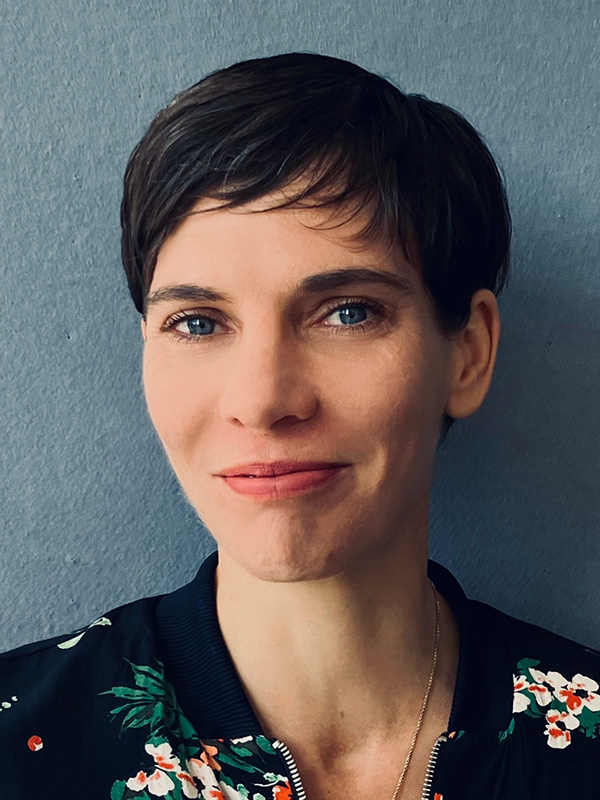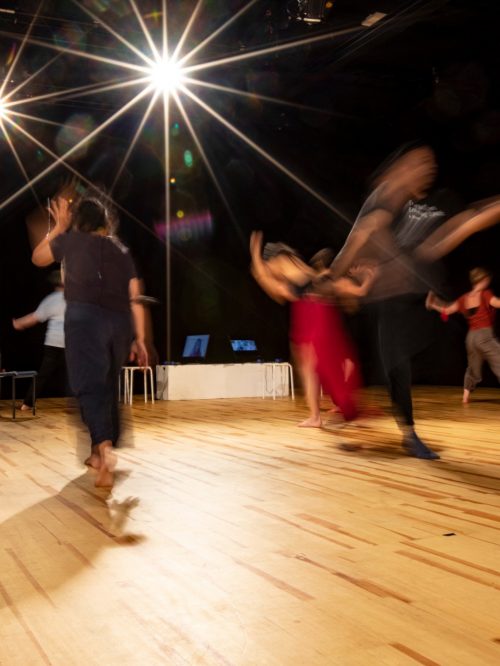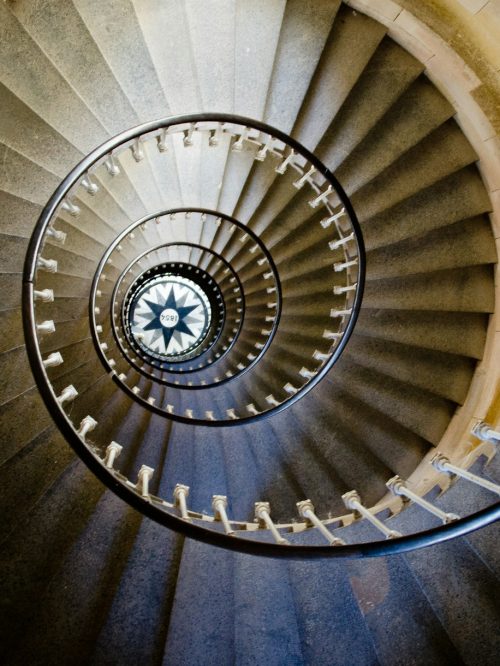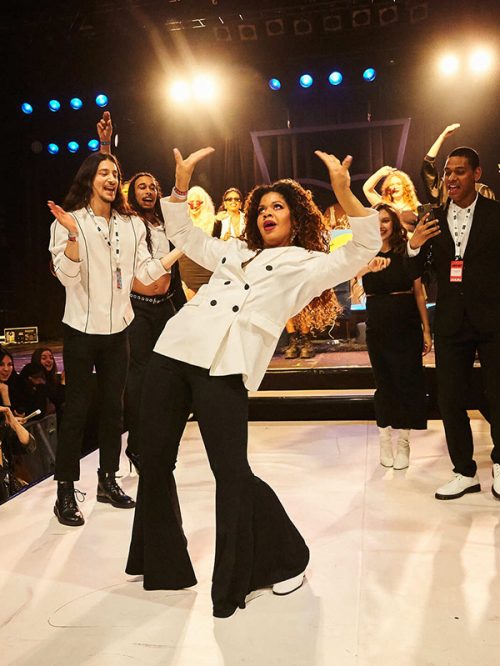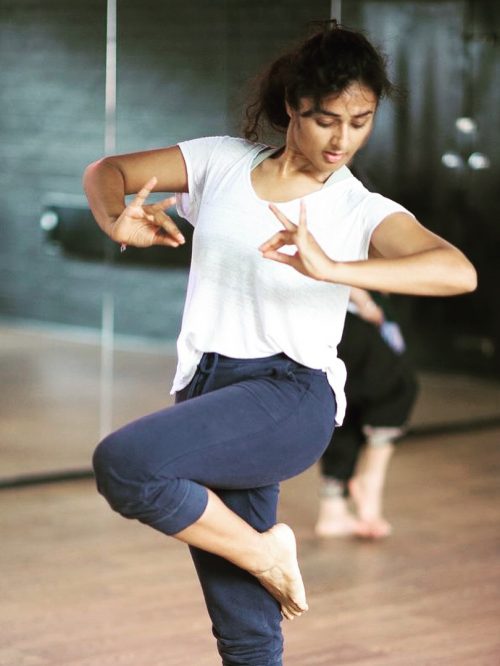Putz, der auf der Netzhaut juckt.
Ich bin Sarah. Weiß, heterosexuel, cis-gendered. Geboren in den 80er Jahren und aufgewachsen in einer bürgerlichen fünfköpfigen Familie in einer Kleinstadt in West-Deutschland. Ich lebe heute in Berlin, bin einigermaßen viel umgezogen und gereist und erziehe meinen Schwarzen Sohn alleine. Seit 15 Jahren arbeite ich in den freien darstellenden Künsten, in lokalen, nationalen und internationalen Kontexten. Ich studierte Dramaturgie für Sprechtheater an einer konservativen Institution in München.
Was prägt meinen Blick? Was schreibt sich in meinen Blick ein? Wie ist er sozialisiert? Wie geformt, konstruiert? Was stört meinen Blick? Was erschüttert ihn, regt ihn an, fordert ihn heraus? Kann ich meinem Blick trauen? Was übersehe ich? Was sehe ich überhaupt?
Die Zeilen sollen zeigen, von wo ich spreche, schreibe. Was meinen Blick, meine Perspektive auf die Welt geprägt hat, prägt. Das Verfasste legt einen Ausschnitt dar, ist ein Anfang. Sicher ist: Der Blick, den ich auf die Welt werfe, hat eine Geschichte. Er ist geprägt, aufgeladen, markiert. Der Blick, mit dem ich auf Produktionen in den darstellenden Künsten blicke, ist (folglich) auch aufgeladen - nicht neutral. Oder voraussetzungslos oder frei von Er-/ Gelebtem, - der eigenen Geschichte, kultureller Prägung. Kein Blick ist das.
Bohrt mein Blick? Tut er weh? Wie bewusst sind mir seine Grenzen? Kann ich meinen Blick weiten? Wie? Blicke ich immer gleich? Kann man den Blick trainieren? Wie ist der Vorgang, zwischen sehen und verstehen? Kann ich falsch gucken?
Mein Berufsbild der Dramaturgin basiert zu einem gewissen Anteil auf meinem Blick. Sicher ebenfalls auf dem Wissen, über das ich verfüge, meinen Fähigkeiten zu analysieren und zu kommunizieren - jedoch basiert er eben auch auf meinem Blick. Ich gucke und erlebe Tanz und Performances, da es Teil meiner Profession ist. Als Dramaturgin muss ich quasi professionell gucken können. Das ist die Erwartung von Kolleg:innen, Arbeitspartner:innen, Publikum und meine eigene. Lange Zeit, die Zeit, als ich noch überwiegend mit weißen und westlich geprägten Künstler:innen arbeitete, hatte ich ein gewisses Selbstbewusstsein. Ich war gemeinhin sicher, dass mein Blick und das, was als Reflektion aus ihm entsteht, bereichernd, anregend, weiterführend ist - und zwar für alle meine Arbeitspartner:innen. Gesunde Selbstüberschätzung. Ermutigende Naivität? Leichtsinn einer Berufsanfänger:in - und/oder lustvolle Hingabe an die Aufgabe. Alles zusammen.
Was übersehe ich? Wie werde ich mir bewusst, dass ich etwas übersehe? Muss ein Blick sich von Kontext zu Kontext verändern, um dem Gesehenen gerecht zu werden? Wie flexibel ist der Blick? Ist Flexibilität gut? In welchem Sinne? Woher kommt die Bewegung, die ich sehe? Wie wird der Raum genutzt und warum?
Dann kamen die Risse - nicht plötzlich, sondern schleichend. Das Selbstbewusstsein bröckelte. Dem Blick fiel der Putz in die Augen. Endlich!?! Einher ging das weiße Geriesel mit einer sich verstetigenden Arbeit mit Choreograph:innen und Künstler:innen des sogenannten globalen Südens, insbesondere des afrikanischen Kontinents. Kollaborationen mit Künstler:innen aus dem Tschad, der Elfenbeinküste, Madagaskar oder dem Senegal ergaben sich. Nicht einfach so, sondern u.a. durch: meine Liebes- und Lebensgeschichte mit einem Choreographen aus dem Tschad, ein gewisses Können im Bereich der Dramaturgie, Zugriff auf strukturelle Fördermaßnahmen und das Interesse sowie die Faszination für die verschiedenen künstlerischen Handschriften. Letzteres animierte mich, so viele Produktionen wie möglich zu sehen von Künstler:innen des afrikanischen Kontinents und der afrikanischen Diaspora .
These words are intended to show where I am speaking and writing from. What has shaped, continues to shape my view, my perspective on the world. What I have written is an excerpt, a beginning. One thing is certain: the gaze I cast on the world has a history. It is shaped, charged, marked. The gaze with which I look at productions in the performing arts is (consequently) also charged – not neutral. Or unconditional or free of experience or lived experience – of one’s own history, cultural imprint. No gaze is.
Und wie die Bühne verstanden? Woher kommt das Verständnis? Auf welche Praxis, Tradition und Technik können die ausgeführten Bewegungen zurückgeführt werden? Was ist das Referenzsystem der Bewegungen?
Ich wurde süchtig - reiste zu Festivals, las, ließ mir Videos senden.
Es wuchsen Kenntnisse und das Gefühl, mit einer bestimmten Materie zunehmend vertraut zu werden. Aber: Je mehr ich sah und las, desto unverkennbarer wurde, was ich beim Besuch der Inszenierungen alles nicht sah, nicht dekodieren konnte oder schlicht ganz anders oder gar nicht erlebte, da ich eine weiße westliche Dramaturgin bin. Mein Blick, Standbein des geliebten Berufs, stand mir im Weg. Er war zu eng, zu unwissend, zu westlich, zu … - er hatte sich, trotz all der Aktivitäten und Bemühungen, noch nicht wirklich auf den Weg gemacht. Klebte fest. Code nicht erkannt. Kein Zugriff möglich.
Wer bestimmt, wie Feedback gegeben wird und wie Kritik funktionieren kann? Was wäre eine Dramaturgie und wie müsste sie zu verüben sein, wenn sie dekolonialisiert ist? Was heißt es Dramaturgie im Tanz zu dekolonialisieren?
Er klebte also - der Blick - an altbekannten westlichen Rezeptionsmustern und Sehgewohnheiten. Aua. Mir das einzugestehen, mir zu sagen, dass Wissbegierde und Lerneifer zwar nicht vergebens, aber nicht zu einer grundlegenden Störung und Veränderung der erlernten Sehgewohnheiten führten, war - ernüchternd. Auch unangenehm: Die Erkenntnis, dass der Hang alles zu rationalisieren, zu verstehen und zu verordnen wollen, auf gewisse Weise eine Reproduktion von kolonialen und somit immer auch rassistischen Mustern ist. Aua.
Was wäre eine Dramaturgie und wie müsste sie zu verüben sein, wenn sie dekolonialisiert ist? Was heißt es Dramaturgie im Tanz zu dekolonialisieren?
Zusammenbruch. Weißes Rauschen. Grübeln. Scham. Dann der Ruck: Es gilt die eigene Position, den Blick, die Macht, den Einfluss auf kreative Prozesse in Frage zu stellen. Grundlegend - hatte ich aber nie gelernt. Schwächen oder sagen wir fehlende Kenntnisse zu benennen, zu markieren und als Beginn für eine neue Begegnung zu verstehen - das hatte ich nicht gelernt. Hilft nichts. Verlernen (nicht einfach). Neu erlernen (ebenfalls nicht einfach). Ausprobieren, sich befragen, ob es einen Weg gibt, als Dramaturgin da zu bleiben, wo es mich hingespült hatte, in den Bereich der internationalen und interkulturellen Arbeit.
Wie kodieren sich Identitäten im Tanz durch Bewegungen, Tanzpraktiken, Musiken und Sounds? Was macht Spezifität aus und wie können wir diese jeweils verstehen, nachvollziehen?
To return to the gaze - my working tool - the question arose as to how after all I could broaden it, adjust it, make it more adequate with an eye on the various cultural contexts, understandings of the world, movement and art that this gaze encountered. The specifities of knowledge and the techniques that it encountered. Question(s).
Listen:
Please note: Audio is in German and English. You can find the full English transcription here [1].
When you listen to the explanations about dance and performances and the corresponding working methods and life paths on Listening Bodies, you will hear history, hear struggle, hear resistance and then see it much more clearly, in the works of the artists interviewed, but in my eyes also beyond that.
You can listen to all the podcasts here
[1] English transcript of soundfile:
Sarah: Und dann kam das Hören. Eine neue Liebe zum Zuhören. Plötzlich. Vielleicht aus der Ruhe, vielleicht wegen der Pandemie, vielleicht weil ‘Listening’ seit einem Moment in verschiedenen Kunstbereich stark an Bedeutung gewinnt.. Ich wollte in jedem Fall nur noch zuhören und zwar: Künstler:innen; Choreograph:innen, Performer:innen & Tänzer:innen die über ihre Arbeit sprechen. Mit Ruhe und Zeit und ohne Publikumsgespräch-Publikum. Und dann wollte ich Künstler:innen und ihrem Wissen aus der Praxis eine Plattform geben - auch andere sollten ihnen zuhören können - ihre Sicht auf Bewegung, Körper, Raum, künstlerische Werdegängen, politischen Kämpfen und deren Einschreibung in das jeweilige Schaffen. Denn trotz all betriebener Lektüre und Recherche -, das fehlte (mir): oral history über Tanz direkt aufs Ohr!
Patrick Acogny: So what’s the difference between a street in Douala and a street for instance in Paris, in France, let’s say the Trocadéro? Are you free to choose where you are going to perform? Or is it so that in Europe you would have to perform where they tell you to?
Zora Snake: To me, public space … is about humanity. It is the first word that comes to my mind when I think of the streets in Cameroon where I grew up. It is about us humans. It’s not even so much about geography, the concrete physicality of the place, it’s about humanity. What it means is that creating in the public space in Cameroon is extremely rich and inspiring. You walk around in some neighborhoods, you pass by a yard where a family lives, you walk through their yard, and, by doing so, you access an intimate space. So that’s why I conceive public space as a fundamentally human space. […] There is a big difference when I perform on the busy streets in Douala with very dense traffic and hot weather, or when I perform on a French or a European street that has been suggested to me by the director of a theater. The act itself is different. On the streets of Douala or Yaoundé, it has a mystical connotation because it’s not part of people’s daily lives, so it causes strange and schizophrenic interactions, some even throw insults, but most people are mostly curious. We are living in a world that is invaded by technology, by machines, but suddenly people all converge to you because there is energy emanating from you, you attract them like a magnet, they take their phones out because they are so surprised that they want to capture the moment to share this miracle later on with other people who could not attend. And without even being aware of it, they themselves become performers. Of course, my work and I serve as a trigger, but they all become performers, dancers even, because they are in motion, they speak, they sing, they become live interpreters through their words, as they give meaning to what is happening. […]. So, it’s the crowd itself that attracts other people, which made me wonder: who is this crowd made of, this crowd of people who have come to see my performance on the streets in France? They are so focused, respectful, they sit down, they improvise, observe. They are silent. They have been bottle-fed with theater. You can see it in their behavior, in the way they watch quietly, but it’s supposed to be performing arts you know, it’s supposed to be lively. So, when I became aware of this, I tried to bring in other dramaturgical elements. It was a lesson for me. Now, when I create, I try to provide some space for improvisation in order to disturb the invisible within the bodies.
Ich fand Verbündete, bekam Fördergelder und konnte mich hinsetzen und überlegen, was es heißt, eine Plattform zu kreieren, Gelder zu verteilen und dennoch ausgestalten zu können. Ich arbeitete mit der in Südafrika lebenden Kuratorin Rucera Seethal und dem Tanzlehrer, -wissenschaftler und - pädagogen Patrick Acogny (ehemalige Ko-Leitung der École de Sables im Senegal). Dazu kamen der freie Radiosender Refuge Worldwide (Berlin) und der in Manchester geborene kamerunische Soundkünstler Oscar Ngu Atanga. Zusammen mit acht Künstler:innen der darstellenden Künste arbeiteten wir an Listening Bodies einer Podcast-Serie.
Rucera Seethal: would it be right to say that a lot of your art making is in response to.
Nashilongweshipwe Mushaandja: I’m always trying to respond to some kind of end, for example, in the Dance of the Rubber Tree, which is a work that is concerned with erasure. It’s about erasure begins in a colonial photography archives, a photography archive of several places in Southern Africa. I like Zimbabwe, South Africa, in Namibia and as far as Togo, West Africa. Also a photographer called Alexander Hirschfeld. And it took this photography of African subjects. And in the early 1900s, during the genocide of the now mainly Arab people in sun in Namibia. And what we were being invited to do as Namibian artists and working with one German historian is to respond to this to this photography archive. So, yes, we created all kinds of different works in my response through the dance of the repertory was around erasure, how colonial photography was about erasure as much as it was about producing ethnicity at that primitive African subject. They also photography, colonial photography also erased a lot of this implicated in different kinds of erases it epistemic sites or genocides. And so in the dance of the rubber tree, I started to source. Ideas of other forms of erasure. From my culture, from home, for example, erasures that are productive. Right? So thinking of cleansing a space, the museum, the ethnographic museum is a form of erasing that metaphysical, problematic stuff or thinking about the rubber tree source. So I could remember that I come from in the north of Namibia there is a tree called the rubber tree and the mint, which is used for all kinds of ritual of erasure. So, for example, if somebody had a miscarriage or somebody has bad luck or just taking a branch of this shrub, of this rubber tree and putting it, and that’s the way to kind of erase the bad spirits. So for me, that’s a productive notion, erasure…
Listening Bodies ist gegenwärtig eine online abzurufende Podcast-Reihe, in der ausgewählte afrikanische Künstler*innen aus dem Bereich Tanz und Performance Einblicke in ihre Arbeitsmethoden, ihren persönlichen Werdegang, ihre Referenzen und die sozialpolitischen Kontexte sowie das Potenzial ihrer Kunst geben.
Alle präsentierten Künstler*innen leiten Institutionen oder Kompanien auf dem Kontinent und/oder touren international. Die Podcast bietet die Möglichkeit, sich mit den Ansätzen, Einflüssen und Ausrichtungen der Künstler*innen auseinanderzusetzen und gleichzeitig einen Einblick in aktuelle Trends der darstellenden Künste auf dem afrikanischen Kontinent zu geben.
Patrick Acogny: What is your dance about? How would you call it?
Fatou Cissé: I have been inspired by modern dances, traditional dances. But nowadays, I don’t think of my work as dance anymore. I think the definition of dance is too limited. In my work, I think of the body as something very vast. My body a whole space separated from the public space. I keep on developing it in spite of the difficulties. When difficulties arise, there are crossings, there are confrontations, roads that cross, cars that collide. But what impact does it have on me, in me? How does a color change impact me? How do the constructions around me impact me? How does everything outside reflect on the inside? How does it grow inside me to become something else? My process revolves a lot around this question: how to deconstruct what is already there and how to reconstruct it while going beyond the existing? We know what already exists, so how do you go beyond what you already know? Should I keep doing exactly the same things that other people do? Should we all walk parallel to each other? What is normal and what isn’t? Why limit ourselves with rules? Why say my arm can’t go beyond that limit, my fingers can’t touch my back? With dance, when I work with dancers, I explore further, I go off limits to find what lies beyond the limits, beyond the obvious.
Listening Bodies ist gedacht als Ressource für darstellende Künstler*innen und Fachleute, die in Afrika tätig sind, sowie für Kunstschaffende und das Publikum außerhalb Afrikas. Sie ist ein Wissensangebot, das auf verschiedenen künstlerischen Positionen basiert; ein Einblick in Tanz und Performance-Kunst gibt und das Vokabular für die Diskussion der afrikanischen darstellenden Künste in nicht-akademischen Begriffen erweitert. Die Podcast-Reihe soll eine sensible und sachkundige Rezeption von Produktionen des afrikanischen Kontinents ermöglichen und gleichzeitig einen Praxisbezug zu afrikanischen Künstler*innen herstellen.
Rucera Seethal: So this is the universe. That’s. At some point is ready to create. Right. I mean, with initiatives in response to this book, but with other works, how does this come ? Like where does this universe burst from? How do you facilitate its coming?
Edna Jaime: I would say the daily life is the kind of veins that are feeding my heart to beat, feeding my universe so I can be in the markets and just see the movement of the people the way the woman like very earlier are already on the streets. I see the challenges people are doing, for example, informal market activities they have with the police sometimes. Yeah, many situations in everyday life where I am doesn’t matter if I am in my hometown, if I’m touring, if I’m with my kids, if I am in a party just sitting in, sometimes there’s something happening. I would say that all the environments around myself. It’s kind of like bombing the blood for my heart to keep, you know, to keep in action to keep it it’s alive. Recently, I started to add another kind of inspiration. Most of the time, my moment of inspiration would be doing activities with water. Have a very strong connexion with water. Like, yeah, like domestic activities, like washing dishes or washing clothes, but things with water. That moment from the very beginning was the moment I had many, many ideas from creation or, I don’t know, maybe some memories of what I, I saw on the street or a conversation I had. Then I start to connect with very clear and very strong ideas form for creation and all these things. That was the moment I knew that, yeah, it happened like this. But recently I have some stuff, like a kind of intuition. Like I know sometimes some voice is coming to talk with me and also dreams. This is something I’m still it’s very, very, very fresh.
Listening Bodies ist ein Gemeinschaftsprojekt, eine Arbeit, die verschiedene Perspektiven zusammenführt, ein Plattform die Menschen mit ganz unterschiedlichen kulturellen Prägungen und Lebenserfahrungen kreierten, um Wissen zu teilen, das anregen kann, sich mit Bewegungskunst, Tanz und Performance von Künstler:innen des afrikanischen Kontinents zu befassen. Listening Bodies war mein Weg, nachhaltig meinen weißen Blick zu weiten - für eine spezifische Kunstform, für konkrete Arbeiten. Er ist weiterhin weiß - mit allem was dazugehört - aber er wird jetzt auch immer benannt als dieser. Und er schämt sich nicht mehr, weil er sich auf die Schliche gekommen ist in seiner Begrenztheit.
Rucera Seethal: It’s I mean there’s an interesting, almost contradictory picture of this really a moment in your high school or was it? I don’t know if it was most of your high school experience with this kind of very violent context. At the same time, you somehow having access to to to drama education, which is also not not so common, I think, and then a particular connexion to to comedic practise. Chuma Sopotela: So it. became the more. We growing up, it was becoming more and more violent. And I couldn’t take it so. Being, being, being At school. And being a drama council was, for me, a place of solitude. But also I know that I look back that it was a place to cry because I did play a lot of tragic roles. But, but I remember the first role I played was of this young girl who was. who had contracted HIV from from their mother. And the mother had now died. And she was now being chased away from the house. And, you know. But in the lead in that, I learnt that through that experience, I could I could speak about, about HIV and I could play these roles like using my own pain. I could play. These roles and help other people sort of go through their. What they felt was their hindrance. or the things that they couldn’t speak about in public spaces. And I could do that. I guess I’ve always been a lover of public space, but in a very engaging with the public in a very particular kind. of a way. You know. Because even in that, in playing those roles,what gave me satisfaction or was, was when the people will then give us feedback and say, you know, when you play that role, it reminded me of when I was young or they could now say, you know What, I’m HIV positive. And it’s been it’s been this long now, you know, and and I could see the power in that. And what what what made that conversation to happen was the fact that we were sharing parts of ourselves with the audience, which was then not realistically as being. The time. like saying that we. were HIV positive, but we’re. saying that we understood pain. And I think that in that in saying that people that we touched and we moved and and they knew that they were not alone in the world, because I. think that there’s something about to. be said about how when people don’t feel alone, then they become part of a group.
Listening Bodies kann einer dekolonialen Kritik nicht standhalten. Die Basis bleibt, dass eine weiße Frau weißes Geld bekommen hat für eine Projektidee, in die sie Schwarze Künstler:innen einlädt. Aber - anders als bei manchen Zusammenarbeit zuvor - habe ich das Gefühl, dass ich nicht mehr fehl am Platz bin, sondern als Zuhörer:in und Aufbereiterin des Gehörten - an einem Platz mit Zukunft. Das ändert nichts am Privileg, an struktureller Bevorteilung - dennoch sehe ich es als einen Schritt der Veränderung. Ein Beginn für das, was kommen muss, sich ändern muss und sich ändern wird. Putz muss erstmal rieseln, dann muss er jucken, dann muss man ihn raus reiben und dann gibt es vielleicht einen neuen Blick - auf Altbekanntes und Neues. Wer den Ausführungen zu Tanz und Performances und den dazugehörigen Arbeitsweisen und Lebenswegen auf Listening Bodies zuhört, hört Geschichte, hört Kämpfe, hört Widerstand und sieht diesen dann auch viel klarere, in den Werken von den interviewten Künstler:innen, aber in meinen Augen auch darüber hinaus.
Über die Autorin
Sarah Israel arbeitet in (inter)nationalen Kontexten als freischaffende Dramaturgin im Bereich Darstellende Künste und hat in München und Berlin Festivals der Freien Szene geleitet. Seit 2012 entwickelte sie Tanz- und Theaterprojekte, u.a. mit Künstler*innen wie Taigué Ahmed, Anna Konjetzky, Thanapol Virulhakul oder Hermann Yao Nikoko. Sie hat verschiedene Programm zur Förderung und Vernetzung von aufstrebenden Künstler*innen entwickelt und sucht kontinuierlich mit Kolleg*innen die Befragung von Arbeitsstrukturen und -konditionen in den Darstellenden Künsten. 2022 begleitet sie das Festival Freischwimmen meets Rodeo in München, recherchierte mit Kolleg*innen zu Kunst in sozialen Kontexte in Berlin und realisierte zusammen mit Rucera Seethal und Patrick Acogny, die Podcast Serie Listening Bodies / Corps à l'écoutes die Künstler*innen der Darstellenden Künste des afrikanischen Kontinents mit ihren Arbeitsmethoden präsentiert. 2023 kuratiert sie das Programm MOVE_extended des Tanzfestivals MOVE in Krefeld.


